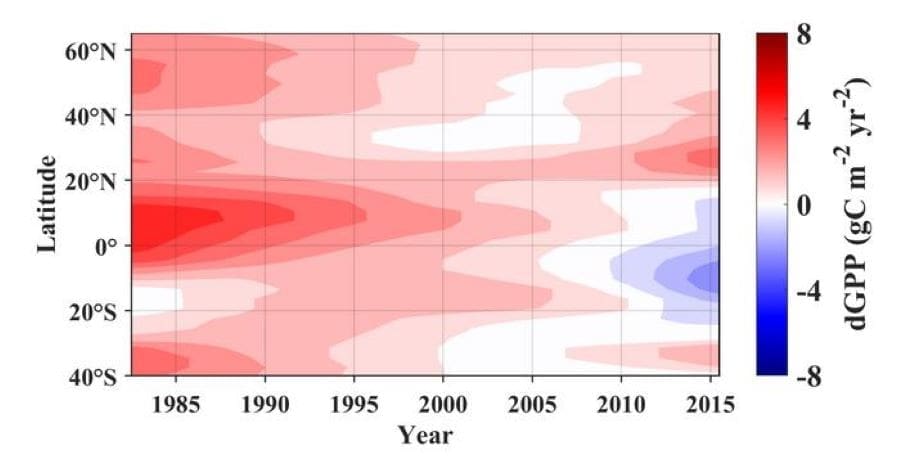Accelerating changes in terrestrial carbon stores are undermining Earth’s ecosystems and jeopardizing climate mitigation efforts.
New research reveals that global gross primary productivity (GPP) – the measure of carbon dioxide absorbed by plants during photosynthesis – has declined across 68% of Earth’s land surface between 1982 and 2016. This alarming trend suggests natural carbon sinks are nearing saturation, posing a critical challenge to achieving the climate goals set by the Paris Agreement.
EHS – The pace at which anthropogenic climate change has altered the terrestrial carbon stores is making our current climate-change mitigation efforts seem fruitless, unless behaviors are quickly changed.
Climate change induced by human behaviors, or anthropogenic climate change, has been a hot topic for decades and is not going away. As with any problem, reviewing datasets from the past to analyze trends and garner information is one of the first steps towards a solution.
Gross primary productivity, or GPP, is a key indicator of the overall health of an ecosystem and is the amount of CO2 fixed by plants per unit of time and area. Researchers have come together to identify the drivers of change in GPP to gain a more thorough understanding of where the trends are likely to lead us and what efforts must be taken to stay in accordance with the Paris Agreement’s goals of mitigating global temperature increases by at least 2℃.

Researchers published their results in Ecosystem Health and Sustainability in December 2024.
By utilizing a dozen long-term datasets on global GPP from the years 1982-2016, researchers observed a decrease of GPP across over 68% of the terrestrial surface of Earth. This finding alone points to a carbon sink saturation point, establishing a deeper sense of urgency to find ways to mitigate global climate change by altering our carbon-emitting activities.
Carbon sinks are natural features, such as forests, oceans and even the soil that absorb atmospheric carbon dioxide. Unlike humans, which exhale carbon dioxide, plants intake carbon dioxide to produce energy for photosynthesis to occur. If these carbon sinks reach a saturation point, atmospheric carbon dioxide is not being taken up as quickly or effectively.
This leads to further warming of the atmosphere as this greenhouse gas is trapped, in addition to the overall lower productivity of plants.
The trends were identified first by analyzing and comparing GPP trends for the entire period of the study, then each period (1982-1999 and 2000-2016). After this, the temporal evolution of the trends was analyzed and quantified on a global and individual pixel level, and lastly, the environmental factors contributions were quantified using the optimal-fingerprint approach, a linear regression model often used for analyzing climate change information. This procedure is how researchers came to their conclusions on the drivers in the evolution of global GPP trends.
Factors such carbon dioxide levels land use/land cover change (LULCC) are definite contributors to the fall of GPP by over 50% between the first period of the study and the second, but the main driver of this global decrease is more likely to be a decline in the CO2 fertilization effect.
“The decline in the CO2 fertilization effect is suggested to be the main driver accounting for the slowing-down of global GPP trends. Although it still has positive effects, the impact of rising CO2 on GPP on a global scale fell by about one-half from 2000 onwards compared to its impact in 1982–1999,” said Songhan Wang, researcher at Nanjing Agricultural University and author of the study.
The CO2 fertilization effect essentially points to greater rates of plant growth as atmospheric carbon dioxide is increased. Despite having a higher amount of atmospheric CO2 available, most areas are not seeing the positives of this fertilization effect, theorized to be from a lack of nutrients in the soil and leaves.
If the trends observed in this research continue as suspected, then our current solutions relying on terrestrial carbon sinks are not going to cut it once they reach their saturation point. Future work will rely on mitigating anthropogenic-related global temperature increases by at least 2℃ to reach the climate neutral target proposed by the Paris Agreement.
***
Zihao Wang and Songhan Wang of the College of Agriculture at Nanjing Agricultural University, Joseph Peñuelas at the Spanish National Research Council (CSIC) Global Ecology Unit and Center for Ecological Research and Forestry Applications (CREAF), Torben Tagesson of the Department of Physical Geography and Ecosystem Science at Lund University, W. K. Smith of the School of Natural Resources and the Environment at University of Arizona, Mousong Wu and Wei He of the International Institute for Earth System Science at Nanjing University and Stephen Sitch of the College of Life and Environmental Sciences at University of Exeter contributed to this research.
The National Key R&D Program of China, the National Natural Science Foundation of China and the Jiangsu Provincial Natural Science Foundation for Distinguished Young Scholars, China Association for Science and Technology, Jiangsu Association for Science and Technology, Swedish National Space Agency, Formas, the Eu-Adid funded CASSECS project, NASA SMAP, NASA CCE, the National Natural Science Foundation of China, the Spanish Government grant, Fundación Ramón Areces grant and the Catalan Government grant made this research possible.
Journal Reference:
Zihao Wang, Josep Peñuelas, Torbern Tagesson, W. K. Smith, Mousong Wu, Wei He, Stephen Sitch, Songhan Wang, ‘Evolution of Global Terrestrial Gross Primary Productivity Trend’, Ecosystem Health and Sustainability 10, 0278 (2024). DOI: 10.34133/ehs.0278
Article Source:
Press Release/Material by Ecosystem Health and Sustainability
Featured image credit: Freepik




